Key takeaways:
- Understanding and practicing cultural etiquette, such as the “wai” greeting and removing shoes, fosters respect and meaningful interactions in Thailand.
- Politeness and attentiveness significantly enhance experiences, as seen with Thai Airways’ staff who embody these values in service.
- Respectful communication styles in Thailand include using soft tones, gentle listening, and maintaining calmness to build genuine connections.
- Experiencing local customs, like shared meals and relaxed time perception, highlights the importance of honoring traditions and being present in social settings.
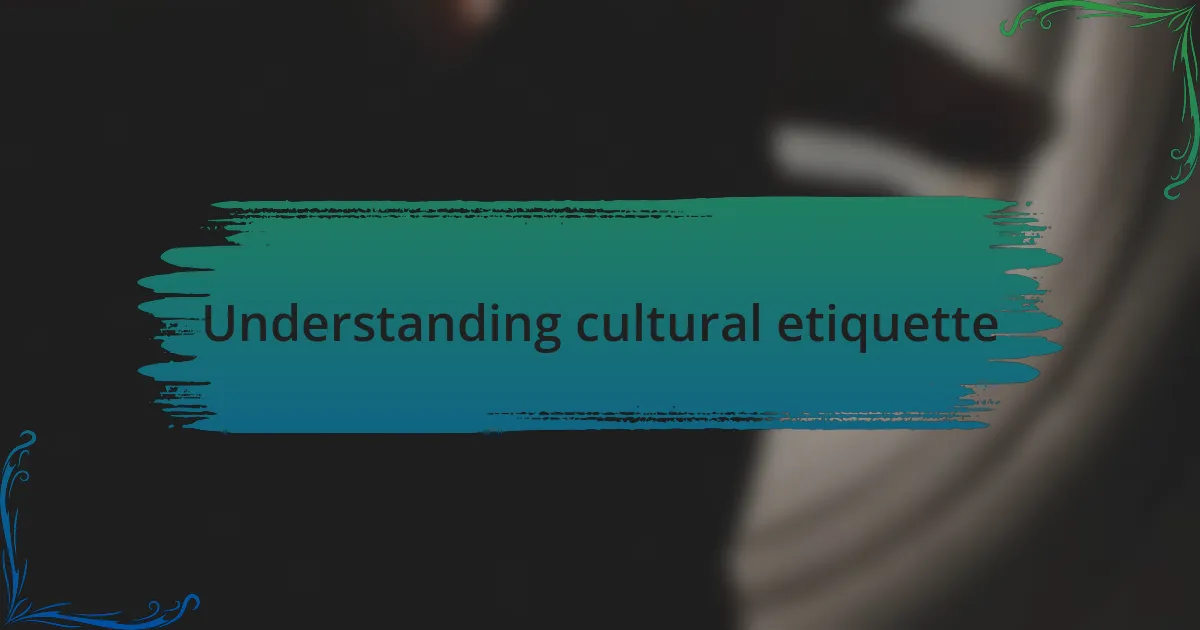
Understanding cultural etiquette
Understanding cultural etiquette is crucial for fostering meaningful interactions, especially in a country as rich in tradition as Thailand. I remember my first trip to Bangkok. As I stepped into a local market, I observed how people greeted each other with a slight bow and a warm smile, rather than a handshake. It struck me that this simple act of respect conveyed a deep sense of community and connection; I felt more at ease knowing that such gestures were an integral part of their daily lives.
Taking the time to learn about the customs, such as removing shoes before entering homes, can significantly impact your experience. It might seem like a small detail, but I felt a sense of humility and respect when I adhered to this practice. It made me wonder—how often do we miss the chance to appreciate the significance of such cultural norms in our own lives?
Additionally, being mindful of the importance of hierarchy in Thai culture helped me navigate social settings more smoothly. In conversations, it’s essential to observe who is being addressed first and to recognize the seniority that shapes interactions. Reflecting on this, I realized how often we might overlook the subtleties of respect that build trust and rapport in any culture.
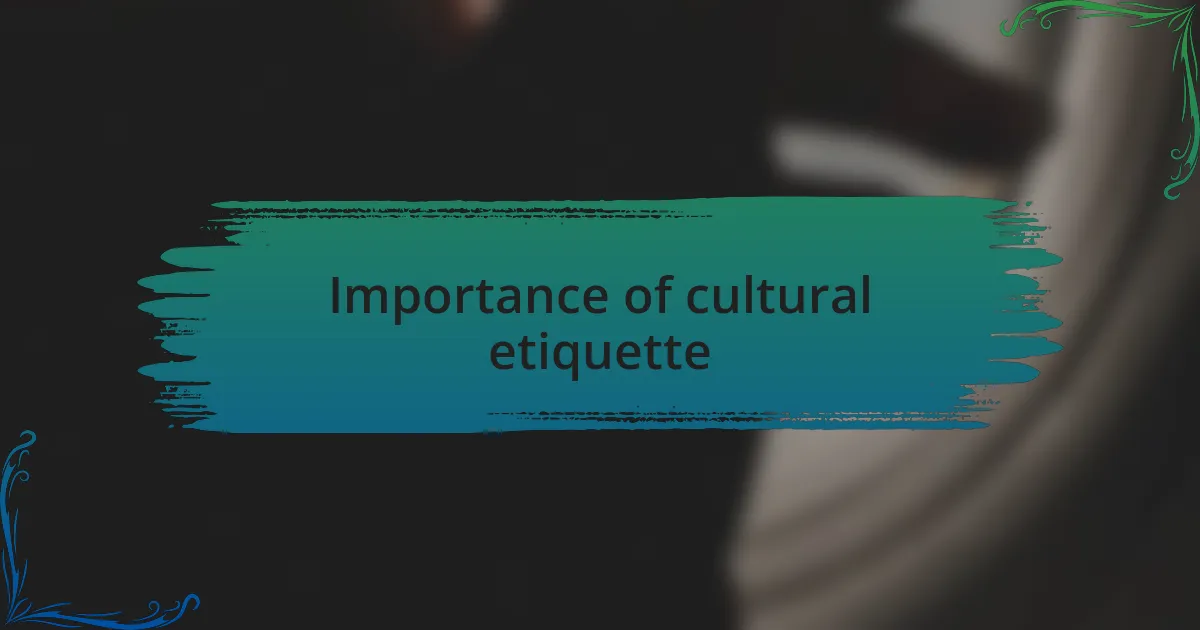
Importance of cultural etiquette
Cultural etiquette serves as a bridge to understanding and connecting with others on a deeper level. I recall an instance where I accidentally pointed my feet at someone, a serious faux pas in Thai culture. The immediate look of discomfort on their face made me realize how vital awareness of such gestures is; every action can communicate respect or disrespect.
Practicing cultural etiquette not only enhances my interactions but also enriches my travel experiences. For example, during a visit to a local temple, I observed how my respectful demeanor opened doors to conversations with locals who were eager to share their stories. It left me pondering—how many meaningful exchanges do we miss when we don’t take the time to understand the customs around us?
Moreover, showing respect through cultural etiquette can lead to lasting bonds and friendships. I remember sharing a meal with a Thai family where I was warmly invited to partake in their traditions. That gesture made me reflect on how often we rush through interactions without appreciating the moments that truly matter. Have you ever thought about how a small act of respect can turn a simple encounter into a cherished memory?
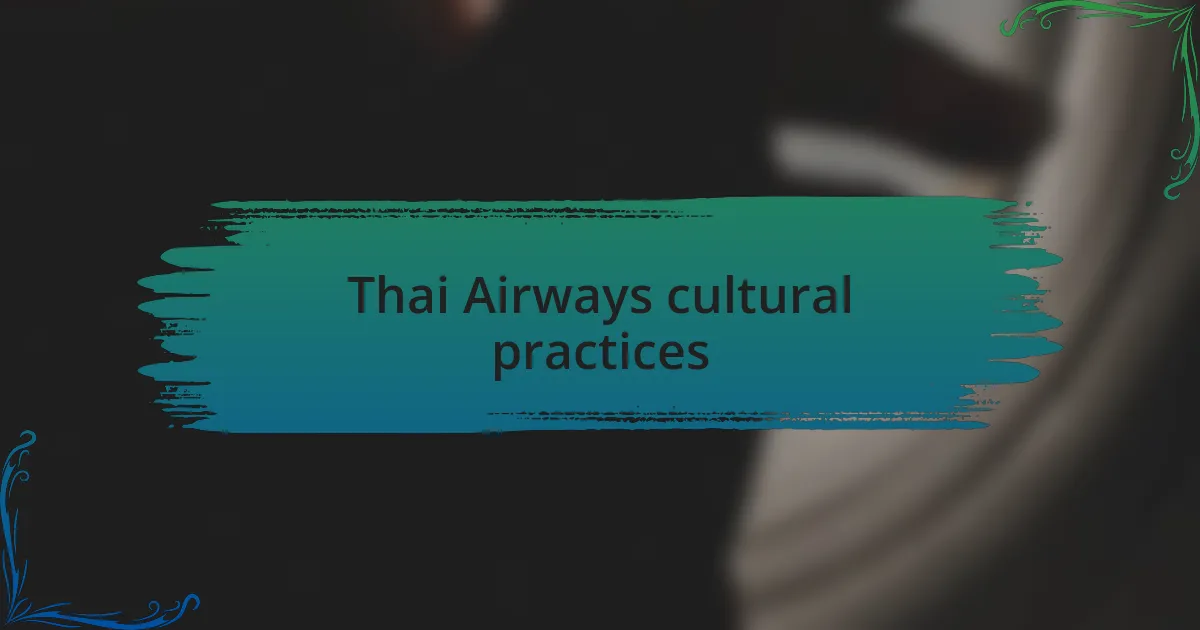
Thai Airways cultural practices
When flying with Thai Airways, I quickly realized the impact of their culturally influenced service. The way the flight attendants greeted guests with a traditional “wai”—a slight bow with hands pressed together—instantly made me feel welcomed and respected. This small gesture, deeply rooted in Thai culture, illustrated their commitment to honor and hospitality, making the journey feel not just about reaching a destination, but about experiencing warmth and connection along the way.
On one particular flight, I noticed how the crew emphasized “sanuk,” or joy, in every service aspect. There was an unmistakable vibrancy among the staff, as they shared friendly banter while also attending to passengers’ needs. It struck me that their approach was more than a job; it was about cultivating a lively atmosphere. How often do we consider the energy we bring to our work, especially in fields that rely on human connection?
I appreciate how Thai Airways incorporates cultural elements into their in-flight experience—whether it’s the delicious Thai cuisine offered or the traditional music playing softly in the background. Each detail contributes to a cohesive cultural immersion. I often reflect on how these practices not only elevate the travel experience but also offer a glimpse into the rich tapestry of Thai culture. Isn’t it fascinating how travel can become a gateway to understanding a nation’s identity?
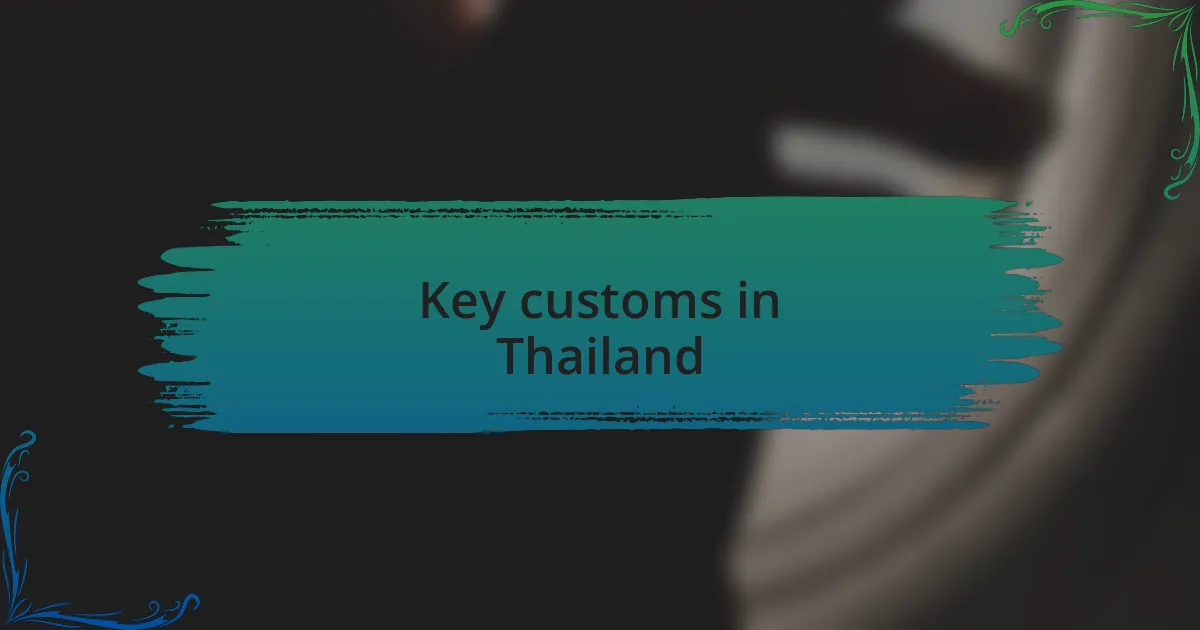
Key customs in Thailand
One of the most striking customs in Thailand is the importance of the “wai,” a gesture I encountered not just within the airline, but throughout my travels. I remember stepping into a small local shop where the owner greeted me with a warm smile and a poised hands-together motion. It made me pause and reflect on how this simple yet profound gesture symbolizes respect and greeting. Have you ever felt that warmth in other cultures, where a simple action can carry so much meaning?
In addition to the “wai,” I found that addressing people properly is crucial in Thai society. Thai names can be intricate, and using the correct honorific, like “Khun” for Mr. or Mrs., truly reflects your respect for the individual. I remember fumbling with names at a dinner party, but the locals appreciated my effort to use these terms even if I got them slightly wrong. It draws me to think—how much do we take the time to know the names of those we meet, especially during our travels?
Another interesting aspect is the dress code, particularly when visiting temples or sacred places. It surprised me to learn that modest attire is not just a recommendation but a reflection of respect towards the culture. I distinctly recall visiting Wat Pho, where I had to cover my shoulders and knees. These customs have taught me that understanding and respecting local practices can deepen one’s travel experience—have you found that adhering to local customs can create memorable connections during your journeys?
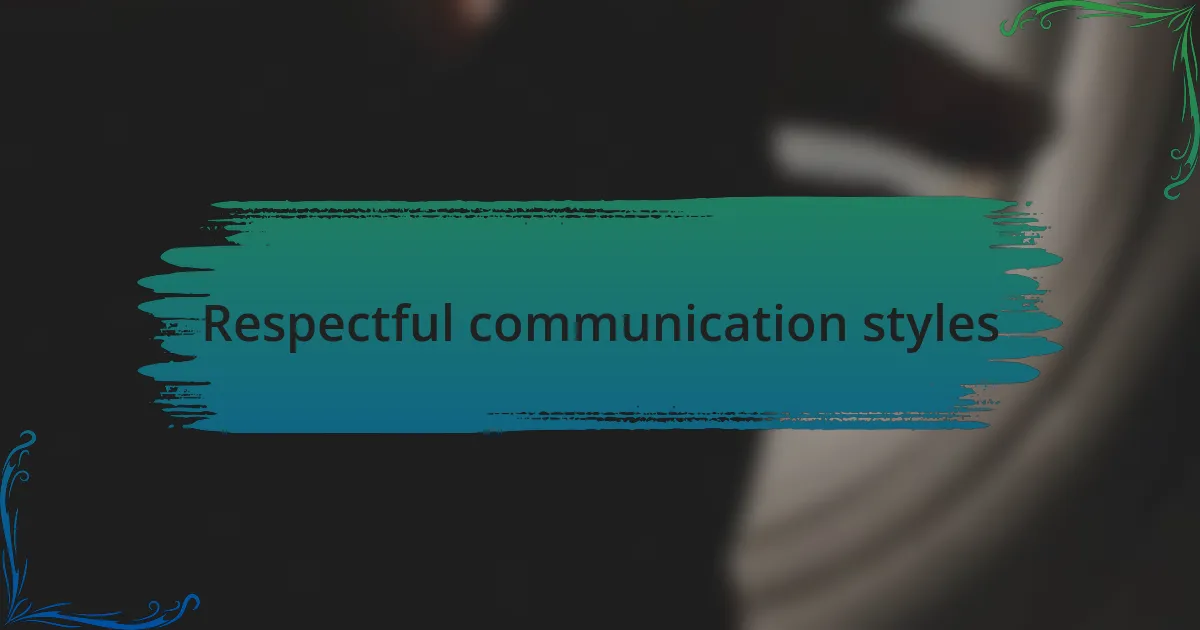
Respectful communication styles
Respectful communication in Thailand is not just about words; it’s woven into everyday interactions. I remember being at a bustling market where a vendor patiently listened to me, nodding gently as I stumbled over my Thai pronunciation. It struck me how that simple act of attentiveness made me feel valued and encouraged me to continue speaking, showcasing the deep-rooted appreciation for listening as a form of respect.
Another aspect I noticed is the importance of maintaining a calm demeanor during conversations. When faced with a misunderstanding, I once saw a local gracefully smile rather than react negatively, which diffused tension entirely. This experience made me ponder—how often do we allow our emotions to dictate how we communicate? Embracing patience and kindness can transform interactions and foster genuine connections.
I also learned that using a soft tone was highly regarded. During a flight with Thai Airways, the flight attendants spoke with soft, gentle voices that created an atmosphere of calm. It reminded me of how a soothing tone can elevate the experience and make others feel at ease. Have you ever noticed how the way someone speaks can profoundly impact your comfort level? In Thailand, it’s a beautiful reflection of respect that I found incredibly memorable.
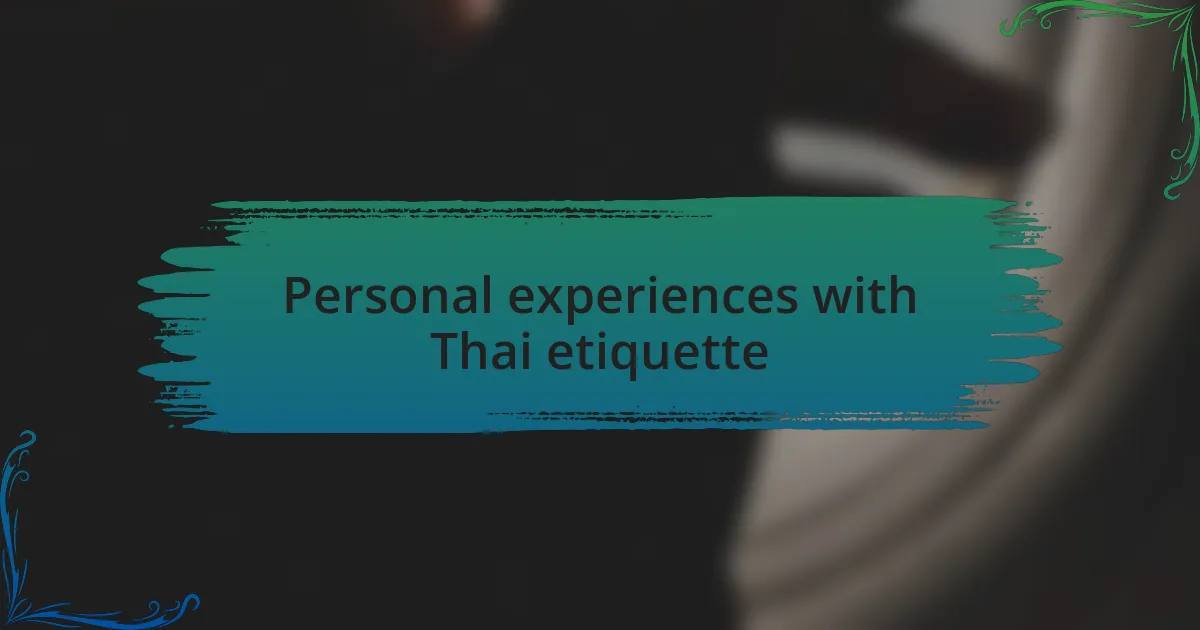
Personal experiences with Thai etiquette
Experiencing Thai etiquette firsthand was a journey that opened my eyes to the nuances of hospitality. One memorable encounter was at a family gathering where I was introduced to local customs over a shared meal. I was struck by the way everyone presented their dishes to one another, a gesture that signified respect and appreciation for the effort put into preparing the food. It really made me reflect on my own dining experiences—how often do we take a moment to honor the food and the people behind it?
Another vivid memory that stands out is when I was greeted with a traditional “wai,” the graceful gesture of palms pressed together with a slight bow. I felt an immediate sense of warmth and inclusion, as if I was being welcomed not just into their space but into their culture. It got me wondering—how often do we extend that level of welcome in our own lives? That simple act taught me the value of acknowledging others and creating an inviting atmosphere, regardless of the setting.
There’s something truly special about how time is perceived in Thailand. I remember being invited to a wedding, where everything seemed to flow with a relaxed rhythm. While waiting for the ceremony to start, I noticed everyone engaging in casual conversation and laughter, seemingly unbothered by the clock. It made me realize how our fast-paced lives might overlook the importance of being present. In that moment, I embraced the magic of taking life a little slower, appreciating the shared connections that truly matter.
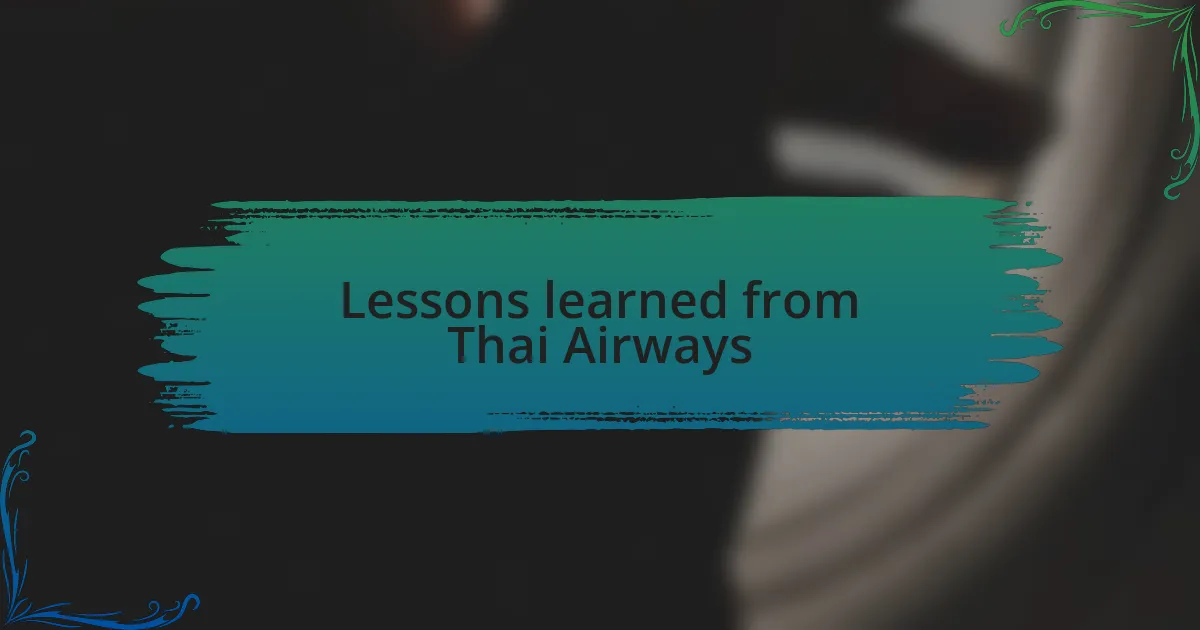
Lessons learned from Thai Airways
One lesson I learned from Thai Airways was the significance of politeness in communication. During my flight, the cabin crew consistently addressed passengers with gentle smiles and courteous language, creating an atmosphere that felt genuinely welcoming. It made me think—how often do we overlook the power of kindness in our daily interactions? That experience reminded me to practice mindfulness in my own conversations, as a little courtesy can go a long way.
Another revelation came from observing how they handle service with grace. On one occasion, an elderly passenger needed assistance, and the crew promptly offered help without a second thought. Their unobtrusive demeanor was impressive; it taught me that being attentive doesn’t mean being intrusive. I found myself reflecting on how I could incorporate this approach into my own professional life, silently supporting others while allowing them the space they need.
Finally, I was struck by the emphasis placed on embracing diversity and community among the crew. Engaging with staff from different backgrounds reminded me that every person has a unique story and perspective to share. I began to ponder: how often do we take the time to learn from those around us? This experience pushed me to seek deeper connections in my own life, fostering an appreciation for the rich tapestry that cultural exchanges bring to our experiences.